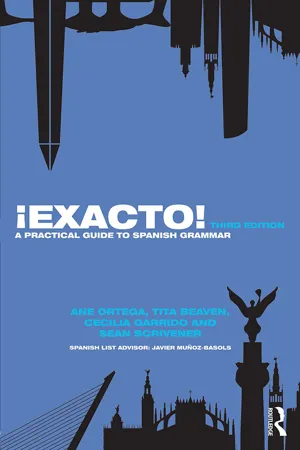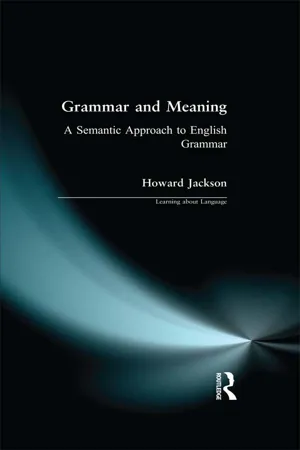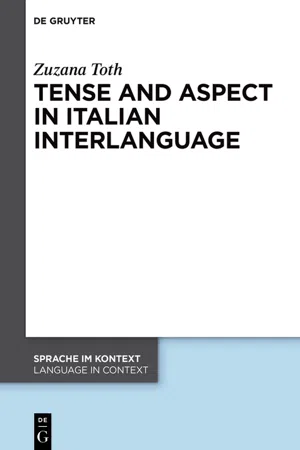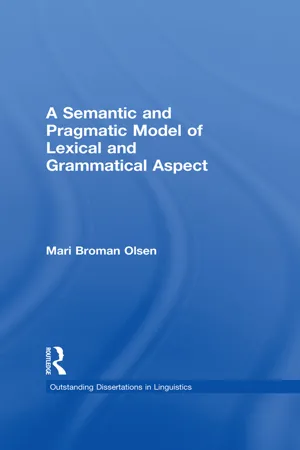Future Tense
Future tense refers to a grammatical category that indicates actions or states that will occur after the present moment. In many languages, including English, the future tense is formed using auxiliary verbs or inflections to convey the idea of something happening in the future. It is an important aspect of language for expressing plans, predictions, and intentions.
6 Key excerpts on "Future Tense"
- eBook - ePub
- Bas Aarts, April McMahon, Lars Hinrichs, Bas Aarts, April McMahon, Lars Hinrichs(Authors)
- 2020(Publication Date)
- Wiley-Blackwell(Publisher)
...See Declerck and Depraetere (1995) for an alternative proposal. While many scholars, including Hornstein, have observed that English lacks a true Future Tense like that of French, there is disagreement about the implications of this fact for the tense system of English. Many, including Comrie (1985), view English as having a past–non‐past tense distinction. The rationale for this analysis comes from the supposition that the English present tense does not denote present time, since it is also used to express future events and temporally unbounded situations, in particular generic ones. However, as we saw in Section 10.3, both futurate present and generic predications can be seen as the products of stative coercion triggered by the aspectual selection properties of the present tense. It is therefore reasonable to conclude that the English tense system is based instead upon a past–present distinction: English lacks a Future Tense but has both a past tense and a present tense. Each of these tenses can combine with the auxiliary head of a periphrastic aspectual construction, including the progressive, the perfect, and the modal future. In specific contexts of use, as we have seen, each of these auxiliary‐headed constructions may be used in place of a simple tense in a predication: the progressive replaces the present tense when an event is being reported as ongoing at speech time, the past tense replaces the perfect when the speaker is referring to a specific past interval, and the present tense replaces the modal future in the subordinate clause of a futurate conditional sentence. These interactions need not, however, be taken to imply that the perfect, progressive, and modal‐future constructions are tenses...
- eBook - ePub
- David Kilby(Author)
- 2019(Publication Date)
- Routledge(Publisher)
...Chapter One Tense and Aspect The basic structural form of the English verb group is quite well known and poses few problems; furthermore, the details have been analysed many times in the literature (from virtually every theoretical perspective). We can analyse it as follows, omitting the specification of which suffixes are appropriate on the various elements: This formula begs certain questions: how are the suffixes specified? does the order of elements in the verb group need to be specified arbitrarily, or does it follow from more general principles? what is the categorial status of all of these elements? These are questions that have been beaten to death in the transformational literature, their major characteristic being that they bear on the types of grammatical device available in linguistic theory. I shall not be concerned with these questions, but rather with the meaning of these various options, and the problem of their compatibility with different verbs. There is a useful distinction to be made between 'tense' and 'aspect', both of which are found in English. Tense is a category which primarily involves the time of the event or state specified by the verb relative to the moment of utterance; aspect, on the other hand, is notoriously difficult to define: it is perhaps best to see it as focusing round such concepts as completion, repetition, habituality, etc. Look first at the category of tense in English: any of the positions marked 'suffix' in (1) are in principle available to be filled with a tense marker (which on the most regular of verbs corresponds to –0,– s or – ed). It is sometimes assumed that English has three tenses – past, present and future – but in fact there are only two relevant formal distinctions in English (–0 and – s are of course a single option, the difference between them not being a matter of tense, but rather the person and number of their subject noun phrase)...
- eBook - ePub
¡Exacto!
A Practical Guide to Spanish Grammar
- Ane Ortega, Tita Beaven, Cecilia Garrido, Sean Scrivener(Authors)
- 2018(Publication Date)
- Routledge(Publisher)
...17 Future Tenses of the indicative The Spanish Future Tenses – los tiempos del futuro – are used to refer to actions that will take place after the speaker has spoken. They are very similar to the English tenses used to talk about the future: the future simple (Lo compraré mañana. - I shall buy it tomorrow.) the future continuous (Mañana a estas horas estaremos llegando. - Tomorrow at about this time we will be arriving.) the future perfect (Cuando te despiertes ya habrá llegado Papá Noel. - When you wake up Father Christmas will have been.) and the most common way to refer to the future in Spanish, the future with ir a + infinitive (going to) (Voy a decirle a Luisa lo que pienso. - I am going to tell Luisa what I think.) 17.1 The future with ir a This is similar to the future with ‘going to’ in English. Form It is formed by the present tense of ir a + the infinitive of the verb. (yo) voy a buscar (tú) vas a ganar (él, ella/Ud.) va a salir (nosotros, -as) vamos a perder (vosotros, -as) vais a construir (ellos, -as/Uds.) van a comer Use The future with ir a + infinitive refers to a near future or a not. so immediate, but planned future Vamos a empezar el viaje en Semana Santa. (We are going to start the journey at Easter.) Ejercicios 1 Write sentences with ir a + infinitive, as in the example: Ejemplo (tú, salir tarde) Vas a salir tarde. a (yo, hablar con el gerente) b (Carlos, confirmar el viaje) c (Luis y Mariela, visitar el museo de arte) d (vosotros, no encontrar las llaves) 2 Complete the following postcard using the future with ir a. 17.2 The future simple The future simple – el futuro – is similar to the English future with ‘will’ or ‘shall’: Compraremos la casa este año. (We shall buy the house this year.) Form Regular forms of the future The Future Tense is formed by adding the corresponding endings to the infinitive of the verb...
- eBook - ePub
Grammar and Meaning
A Semantic Approach to English Grammar
- Howard Jackson(Author)
- 2014(Publication Date)
- Routledge(Publisher)
...There is, though, a future point of orientation, which is used to relate future events that are seen as occurring prior to that point. Consider the example at [34]: [34] A good example of the advance in education is that there are now twice as many university students as in 1938, and it is anticipated that by 1970 the number will have more than trebled [B26: 72] This sentence was written in 1961 (‘now’). The second proposition, beginning with and, looks into the future to the year 1970, and then back from that future point of orientation to a situation preceding it — ‘will have more than trebled’. The time of this situation is referred to as past in the future : There would appear to be no ‘future in the future’ corresponding to the ‘past in the past’. [ Exercise 1 ] Tense and aspect The meanings associated with the notion of ‘time’, which we have been discussing so far in this chapter, are realised in the grammar of the language by the systems of tense and aspect. In this section we will consider first of all how tense and aspect are manifested in the forms of the verb. Then we will look more systematically at the relations between verb forms and the meanings we have discussed. Finally, we will comment on some of the relations between tense and aspect on the one hand, and Temporal circumstances and situation types on the other. Verb forms In Chapter 1 we noted that the distinction between present and past tense is encoded in the verb word in English by means of an inflection, e.g. [35] PRESENT PAST stay, stays stayed swim, swims swam think, thinks thought Verbs have two present tense forms and one past tense form (except be, which has three present tense forms — am, is, are — and two past tense forms — was, were). For a few verbs the past tense form is identical to one of the present tense forms (e.g. cut, hit). It is noteworthy that in English there is no Future Tense manifested by inflections in the verb word...
- eBook - ePub
- Zuzana Toth(Author)
- 2020(Publication Date)
- De Gruyter(Publisher)
...Thus, the second verb form conveys the progressive aspect, one of the aspectual meanings that can be expressed by imperfective forms in the Romance languages. In fact, if we translate the sentence into Italian, the verb leggere in the second clause will be marked with an imperfective tense conveying the progressive meaning: (2) Gianni ha letto quel libro ieri; mentre lo leggeva, è arrivato il postino In contrast to the progressive form in English, imperfect forms in the Romance languages convey several aspectual meanings, such as progressivity, habituality, etc. (Ayoun and Salaberry 2005 : 255). Additionally, the forms of verbal paradigms interact with syntactic, semantic and pragmatic factors such as the lexical aspectual value of the predicates, the principles of discourse grounding and the syntactic functions of utterances. This makes the mapping of meanings into forms a difficult task for learners acquiring a Romance language. As pointed out by Ayoun and Salaberry (2005: 281), the conceptualisation of tense/aspect information requires learners to “engage in a multi-level analysis of semantic-discursive and pragmatic meanings”. Consequently, the conceptualisation of tense/ aspect distinctions by the learner is affected by multiple factors, such as semantic congruence between the lexical aspectual value of the predicates and verbal morphology, principles of discourse grounding, distributional biases in the input and L1 tense/aspect system. The following sections review studies on L2/L3 acquisition of tense/aspect distinctions that investigate how these factors shape the acquisition process, referring to hypotheses such as the Lexical Aspect Hypothesis (LAH), the Discourse Hypothesis (DH) and the Default Tense Hypothesis...
- Mari B. Olsen(Author)
- 2016(Publication Date)
- Routledge(Publisher)
...Tense is DEICTIC; it “relates the time of the situation referred to some other time,” that is, to a DEICTIC CENTER, usually the time of speaking (Comrie 1976:1–2, my emphasis; cf. references therein, Reichenbach 1947, and Cann 1993:23, chapter 8). Past tense (3) locates situations anterior to the deictic center, as (3) shows. The present tense in (4) indicates contemporaneity of the situation with the center, and the Future Tense in (5) a situation posterior to it. (3) I lived in an apartment in Puerto Rico. (4) I live in a house in Maryland. (5) I will live overseas someday. Aspect is NON-DEICTIC: it “is not concerned with relating the time of the situation to any other time-point, but rather with the internal temporal constituency of the one situation” (Comrie 1976:5; cf. Smith 1991:135). It represents how an event takes place over time, without linking it to a specific time. Thus, the Russian sentences in (6) and (7) both refer to the same past event: Tolstoy’s writing of War and Peace. However they differ in terms of “a temporal perspective which focuses all or part of the situation” (Smith 1991:xv). According to Smith (1991), the verb form in (6) presents the writing as IMPERFECTIVE, that is, as (roughly) ongoing in the past. The verb in (7), with a PERFECTIVE prefix, presents the writing as (roughly) complete in the past (examples based on Smith 1991:306, 301). (6) Lev Tolstoj pisa -l Vojnu i mir. Lev Tolstoy write -PAST War and Peace ‘Lev Tolstoy was writing War and Peace.’ (7) Lev Tolstoj na -pisa-1 Vojnu i mir. Lev Tolstoy PFV -write-PAST War and Peace ‘Lev Tolstoy wrote War and Peace.’ Thus, tense and aspect are concerned with time from complementary perspectives. Tense indicates whether situations are located at a reference time, which may be anterior to, contemporaneous with, or posterior to a deictic center. Selection of past, present, or Future Tense therefore depends on where the reference time of the situation is located with respect to this center...





